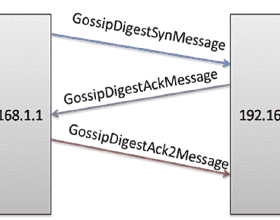We investigate the problem of locating the source of a self-interacting signal spreading in a complex networks. We use a well-known rumour model as an example of the process with self-interaction. According to this model based on the SIR epidemic dynamics, the infected nodes may interact and discourage each other from gossiping with probability $\alpha$. We compare three algorithms of source localization: Limited Pinto-Thiran-Vettarli (LPTV), Gradient Maximum Likelihood (GMLA) and one based on Pearson correlation between time and distance. The results of numerical simulations show that additional interactions between infected nodes decrease the quality of LPTV and Pearson. GMLA is the most resistant to harmful effects of the self-interactions, which is especially visible for medium and high level of stochasticity of the process, when spreading rate is below 0.5. The reason for this may be the fact that GMLA uses only the nearest observers, which are much less likely affected by the interactions between infected nodes, because these contacts become important as the epidemics develops and the number of infected agents increases.
翻译:我们调查了在复杂网络中找到自我互动信号传播源的问题。我们使用一个众所周知的谣言模型作为自我互动过程的一个例子。根据基于SIR流行病动态的模型,受感染的节点之间相互影响,并相互劝阻对方以概率$/alpha$进行八卦。我们比较了三种来源本地化算法:Limite Pinto-Thiran-Vettarli(LPTV),GIDE 最大接近度(GMLA)和基于Pearson时间和距离的关联。数字模拟的结果显示,受感染的节点之间更多的互动降低了LPTV和Pearson的质量。GMLA是最能抵抗自我互动有害影响的,而当传播率低于0.5时,中等和高水平的过程的偏差性尤其明显。原因可能是,GLA只使用最接近的观察者,而受感染的节点之间相互作用影响的可能性要小得多,因为这些联系随着流行病的发展和受感染的媒介的增加而变得重要。





